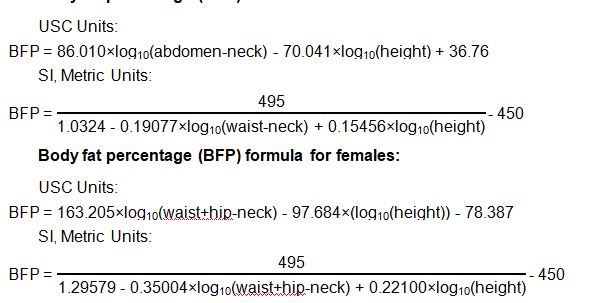Body Fat Calculator
Enter Your Details
Your Results
Body Fat Percentage
15.3%
Fitness
Body Fat (U.S. Navy Method)
15.3%
Body Fat Category
Fitness
Body Fat Mass
23.2 lbs
Lean Body Mass
128.8 lbs
Ideal Body Fat for Given Age
10.5%
Body Fat to Lose to Reach Ideal
7.2 lbs
Body Fat (BMI method)
15.4%
Body Fat, Overweight, and Obesity
The scientific designation for body fat is “adipose tissue.” Adipose tissue has several important purposes. The main purpose is to store lipids which your body can use to generate energy. Additionally, it secretes important hormones, cushions the body, and provides some insulation.
Body fat is classified into essential body fat and storage body fat. Essential body fat is a base level of fat that is found in most areas of the body. It is necessary fat to maintain life and reproductive function. The amount of essential fat is different between men and women, generally around 2-5% in men, and 10-13% in women. The healthy range of body fat is generally considered to be 8-19% in men and 21-33% in women. Although excessive body fat will have many adverse health effects, not having enough body fat will also result in negative health effects, and having a body fat percentage below or at the essential body fat percentage range is an issue to review with a medical professional.
Storage fat refers to fat that is stored in adipose tissue, either subcutaneous fat (deep to the dermis and surrounding organs) or visceral fat (fat within the abdomen and between organs.) When someone refers to body fat, they are usually referring to storage fat. Some storage fat is a good thing but too much storage fat has negative consequences for health.
Too much body fat places an individual in the overweight category, and ultimately the obese category if measures are not taken to reduce the increase in body fat. One should note, being overweight does not necessarily mean having an excess of body fat. Body weight comprises a variety of factors (including, but not limited to body fat, muscle, density of bone, and water), therefore, an individual with a lot of muscle could be labeled as overweight, despite having a healthy amount of body fat.
Body fat gain varies from person to person, due to various reasons including genetic and behavioral reasons (exercise habits, eating habits). Due to these variations, some individuals may find it more difficult to lose body fat, particularly in the abdominal area. Regardless, the evidence shows that through diet and exercise, it is possible to lose fat. Also, keep in mind that women and men will store body fat differently and it can vary over time. After age 40 (after menopause for women) the lack of sexual hormones will result in males adding body fat around their abdomen, while women add body fat around their thighs or butt.
Potential Complications of Excess Body Fat
Obesity is considered one of the top preventable causes of death on a global basis by the World Health Organization (WHO), and it is estimated that this condition accounts for between 111,909 to 365,000 deaths annually in the United States. The concern regarding the health implications related to obesity has been increasing, in part because the Centers for Disease Control and Prevention (CDC) states that 36.5% of adults in the U.S. are defined as obese. Obesity is related to lower quality of life, decreased mental health, obstructive sleep apnea, and the leading causes of death worldwide including cardiovascular disease, stroke, certain forms of cancer, and diabetes. These co-morbidities can decrease life expectancy, making obesity a subject of study for many researchers as it is an important medically relevant condition.
As mentioned earlier in the article, fat produces a variety of important hormones that influence a person’s total body function. Too much or too little of important hormones can result in adverse effects that may prevent a person from functioning appropriately. As it relates to this discussion, studies show that excess body fat, specifically abdominal fat, can disrupt the normal balance and function of some of these hormones. Furthermore, body fat, specifically visceral fat, can release certain cytokines, a wide range of proteins that act in cell signaling, that can possibly increase risk for cardiovascular disease. Visceral fat is directly related to increased levels of low-density lipoprotein (LDL) cholesterol, decreased high-density lipoprotein (HDL) cholesterol, and insulin resistance. LDL cholesterol is classified as bad cholesterol and HDL is classified as good cholesterol. Too much LDL cholesterol can clog arteries and lead to complications that can include heart attacks. Insulin resistance is when cells do not react properly to insulin, which can lead to high blood sugar and in the later stages, type 2 diabetes. Therefore, it is clear, that excess visceral fat can have significant and measurable adverse consequences for an individual’s health.
Measuring Body Fat Percentage
There are various specific methods that have been developed to measure a person’s body fat. The above calculator uses a method based on the equations discussed in 1984 by Hodgdon and Beckett at the Naval Health Research Center. Below is a description of how to measure the relevant body parts and the equations used to measure body fat:
Measurement of the subject’s waist circumference should be taken at the horizontal position, around the navel for males, and at the horizontal position where the subject has the smallest waist size for females. Subjects should not pull their stomach in to obtain accurate measurements.
Measurement of the subject’s neck circumference is taken below the larynx with the measuring tape sloping down to the front of the body. The subject should not flare their neck.
If you are measuring females, measure the subject’s hip circumference at the largest horizontal measure.
Once the measurements are taken, you can use the following equations to estimate body fat using the U.S. customary system (USC)-inches, or the International System of Units/metric (SI)-centimeters.
Body fat percentage (BFP) formula for males:
